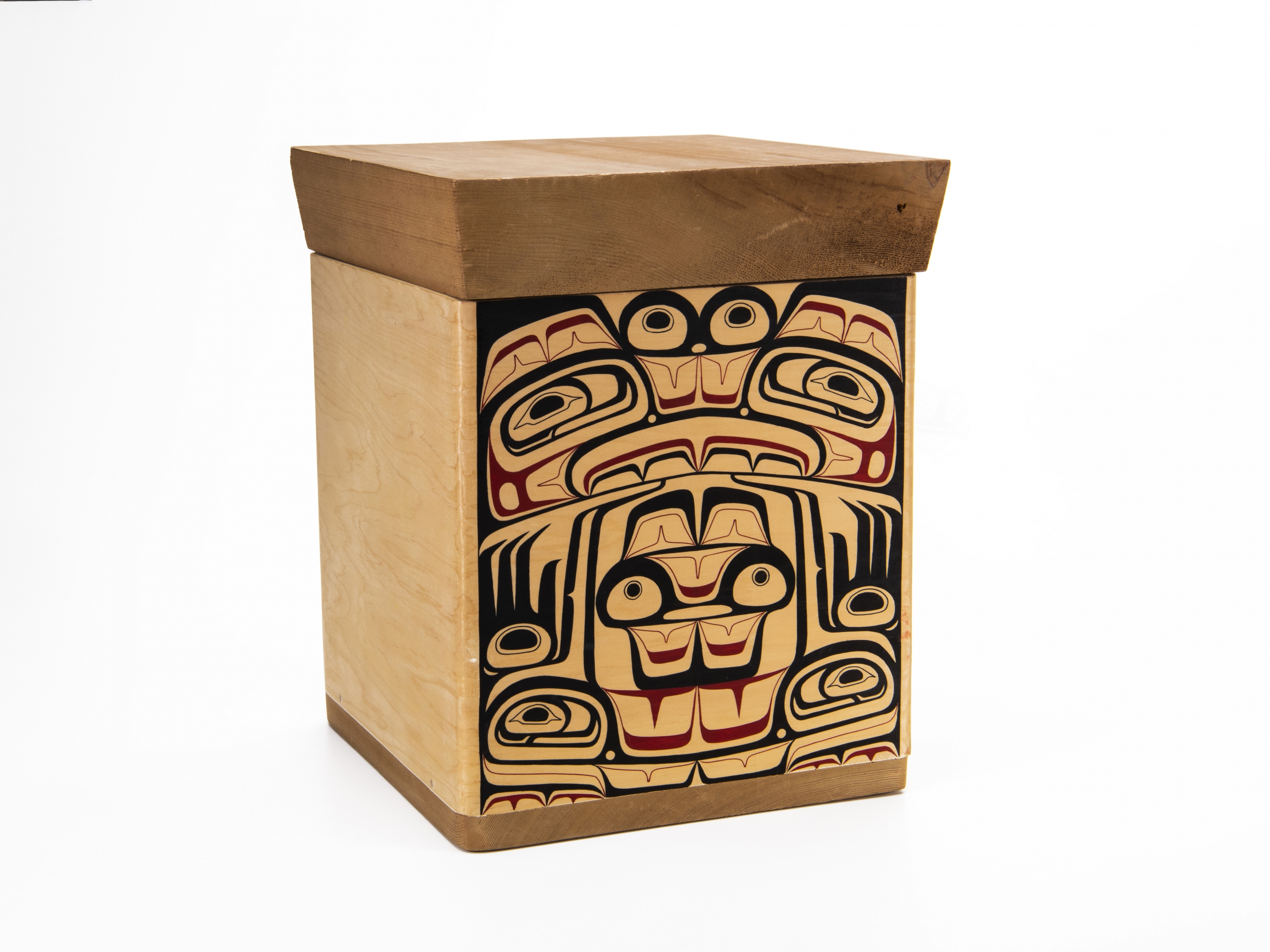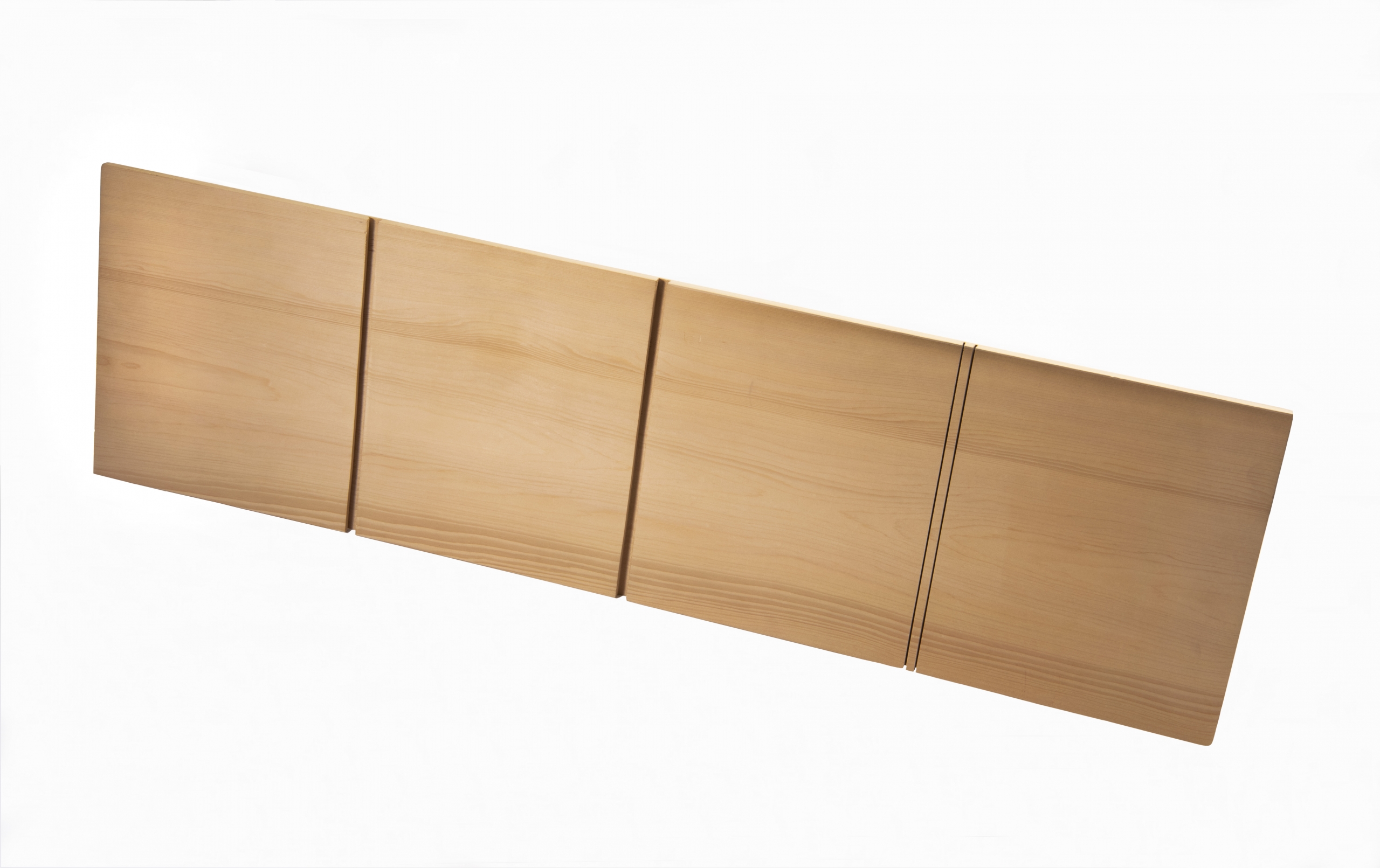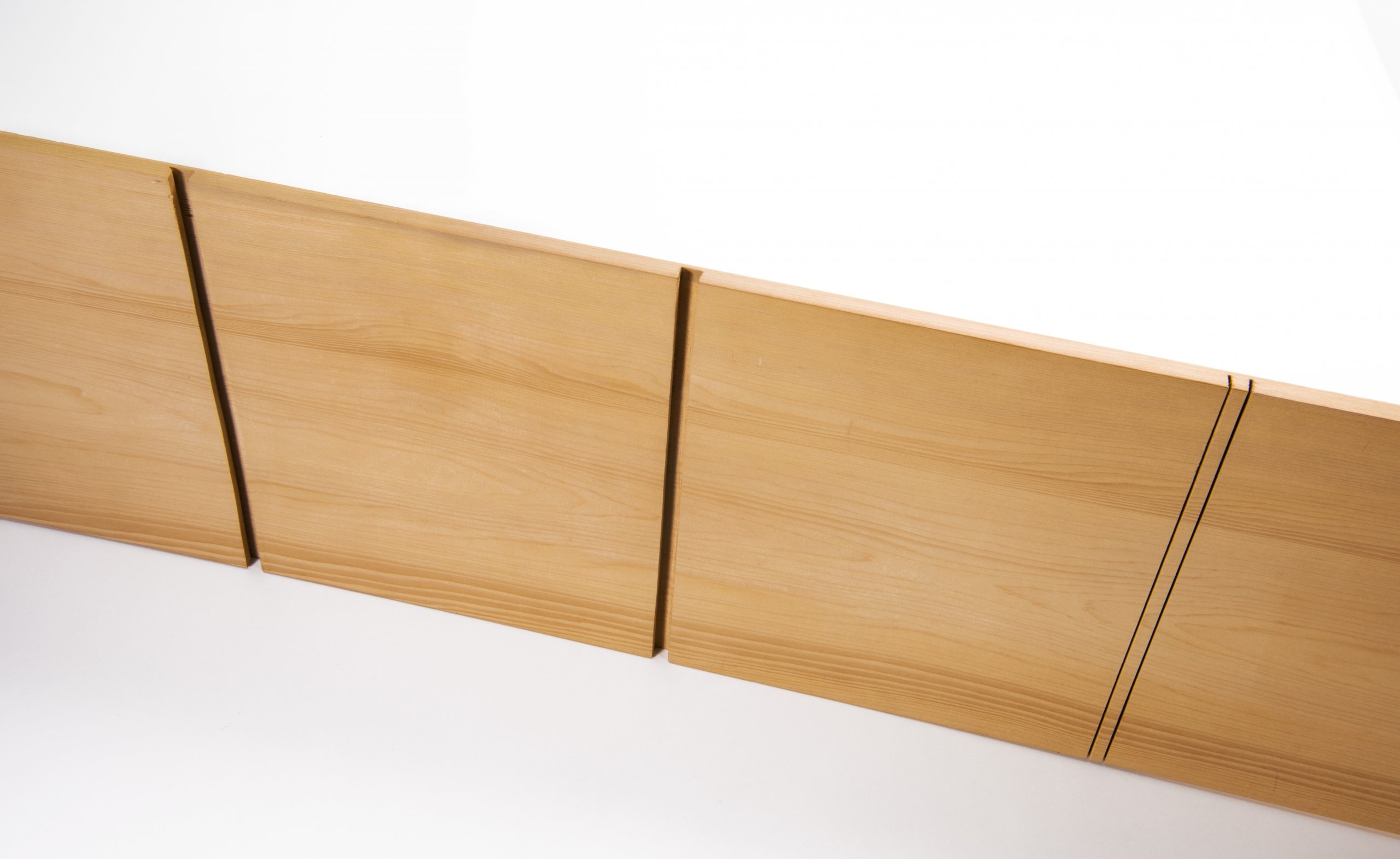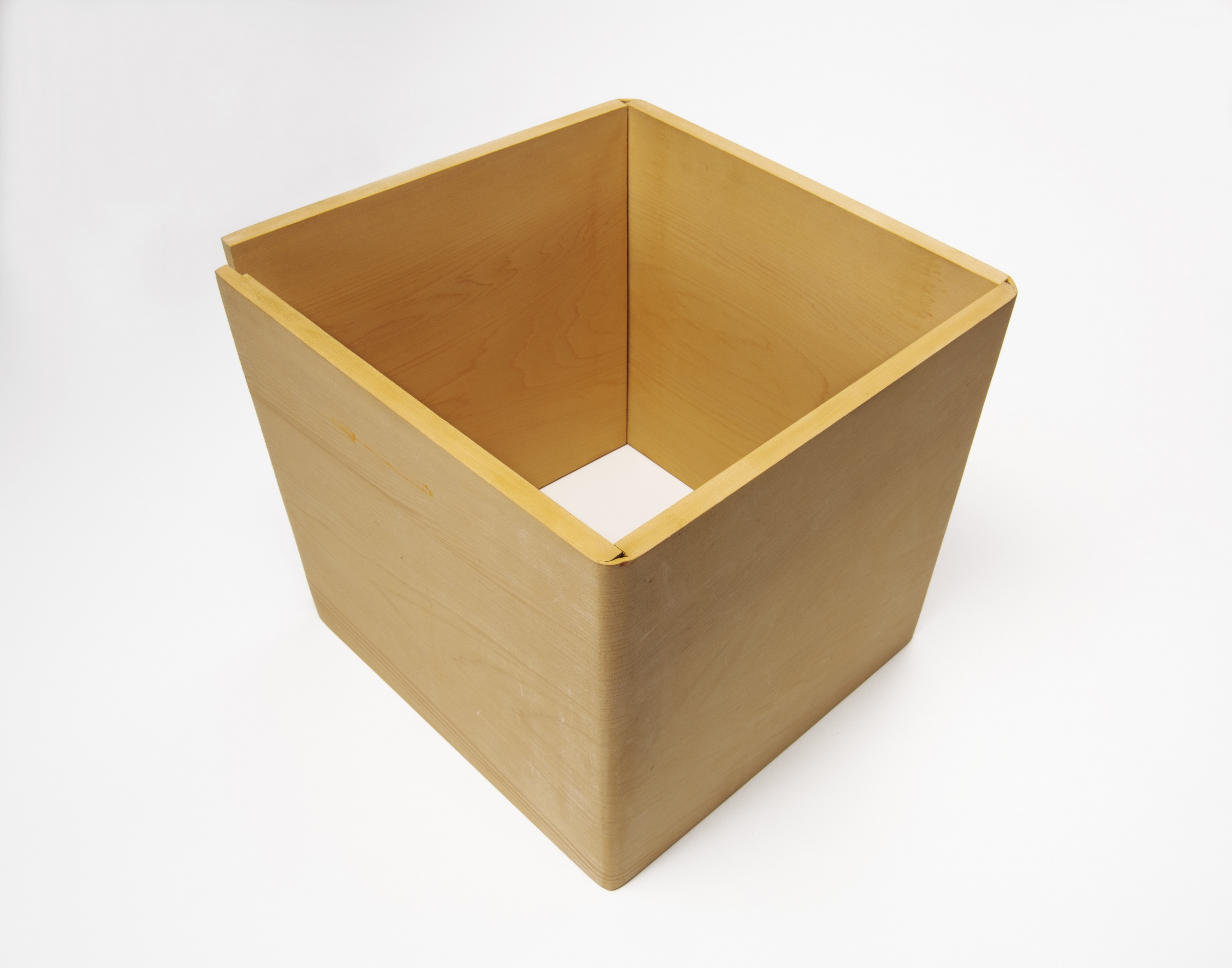Bentwood Box in Progress
Artifact
Image
Video
Audio
 Activities
Activities
LOOK
Look at the tawt’aGaay (bentwood box) at different stages of its creation, and read about its historical context below. In your own words, how would you explain the box-making process?
LOOK
Read the historical context provided on the process of making tawt’aGaay (bentwood boxes). Note any words you don’t understand. Look up what they mean in a dictionary or online.
DO
Do you know what a ts’uu (cedar) tree looks like? Do you have ts’uu (red cedar) or gG̱aahlan (yellow cedar) trees where you live? Do some independent research to find or verify your answers.
Extension: Find out where in Canada cedar trees tend to grow.
Details
 Materials
Materials - Cedar
Historical Context
Choose one of the three levels below to match your needs.
- Tawt’aGaay (bentwood boxes) are made using a unique technology from the Indigenous peoples of the Northwest Coast.
- These are the basic steps in making a tawt’aGaay (bentwood box):
- On a smooth plank of ts’uu (cedar) wood, measure where the corners of the box will be.
- Using a kerfing technique, make sure the wood will bend and fit tightly together at the corners (see picture 2 and 3).
- Steam and then carefully bend the wood into a box shape. Picture 4 shows how kerfing allows for tight corners.
- Fasten the last corner together with nails, rope or dowels, and add a bottom (and perhaps a lid).
- As wanted, decorate with painted or carved formline designs, and add precious materials such as shells. This box has been painted with formline designs on one side.
Tawt’aGaay (bentwood boxes) are made using a unique technology that comes from the Indigenous peoples of the Northwest Coast.
These are the basic steps in making a tawt’aGaay (bentwood box):
- Acquire a plank of wood, usually ts’uu (cedar), and measure where the corners of the box will be.
- Using a kerfing technique, make sure the wood will bend and fit tightly together at the corners (see picture 2 and 3).
- Steam and then carefully bend the wood into a box shape. Picture 4 shows how kerfing allows for tight corners.
- Fasten the last corner together with nails, rope or dowels, and add a bottom (and perhaps a lid).
- As wanted, decorate with painted or carved formline designs, and add precious materials such as shells. This box has been painted with formline designs on one side.
Tawt’aG̱aay (bentwood boxes) are made using a unique technique that originated on the Northwest Coast. These images show the different steps involved in creating a tawt’aG̱aay (bentwood box).
The woodworker cuts a plank of wood from a ts’uu (cedar tree). The plank’s depth, width and length must measure up evenly. Its surfaces must be smooth. Then the woodworker measures the plank and carves out notches. They use a kerfing technique (see picture 2 and 3) to make sure the wood will bend and fit together.
Next, the wood must be steamed and bent into shape. Picture 4 shows how kerfing allows for tight, waterproof corners.
The open corner can be fastened together with nails, rope or dowels. A bottom is included and, often, a lid. Boxes can be decorated with painted or carved formline designs, and inlaid with precious materials such as shells or ivory. The tawt’aG̱aay (bentwood box) we see here has been decorated with black and red formline designs.
- Tawt’aGaay (bentwood boxes) are made using a unique technology from the Indigenous peoples of the Northwest Coast.
- These are the basic steps in making a tawt’aGaay (bentwood box):
- On a smooth plank of ts’uu (cedar) wood, measure where the corners of the box will be.
- Using a kerfing technique, make sure the wood will bend and fit tightly together at the corners (see picture 2 and 3).
- Steam and then carefully bend the wood into a box shape. Picture 4 shows how kerfing allows for tight corners.
- Fasten the last corner together with nails, rope or dowels, and add a bottom (and perhaps a lid).
- As wanted, decorate with painted or carved formline designs, and add precious materials such as shells. This box has been painted with formline designs on one side.
Tawt’aGaay (bentwood boxes) are made using a unique technology that comes from the Indigenous peoples of the Northwest Coast.
These are the basic steps in making a tawt’aGaay (bentwood box):
- Acquire a plank of wood, usually ts’uu (cedar), and measure where the corners of the box will be.
- Using a kerfing technique, make sure the wood will bend and fit tightly together at the corners (see picture 2 and 3).
- Steam and then carefully bend the wood into a box shape. Picture 4 shows how kerfing allows for tight corners.
- Fasten the last corner together with nails, rope or dowels, and add a bottom (and perhaps a lid).
- As wanted, decorate with painted or carved formline designs, and add precious materials such as shells. This box has been painted with formline designs on one side.
Tawt’aG̱aay (bentwood boxes) are made using a unique technique that originated on the Northwest Coast. These images show the different steps involved in creating a tawt’aG̱aay (bentwood box).
The woodworker cuts a plank of wood from a ts’uu (cedar tree). The plank’s depth, width and length must measure up evenly. Its surfaces must be smooth. Then the woodworker measures the plank and carves out notches. They use a kerfing technique (see picture 2 and 3) to make sure the wood will bend and fit together.
Next, the wood must be steamed and bent into shape. Picture 4 shows how kerfing allows for tight, waterproof corners.
The open corner can be fastened together with nails, rope or dowels. A bottom is included and, often, a lid. Boxes can be decorated with painted or carved formline designs, and inlaid with precious materials such as shells or ivory. The tawt’aG̱aay (bentwood box) we see here has been decorated with black and red formline designs.
Summary
- Tawt’aGaay (bentwood boxes) are made using a unique technology from the Indigenous peoples of the Northwest Coast.
- These are the basic steps in making a tawt’aGaay (bentwood box):
- On a smooth plank of ts’uu (cedar) wood, measure where the corners of the box will be.
- Using a kerfing technique, make sure the wood will bend and fit tightly together at the corners (see picture 2 and 3).
- Steam and then carefully bend the wood into a box shape. Picture 4 shows how kerfing allows for tight corners.
- Fasten the last corner together with nails, rope or dowels, and add a bottom (and perhaps a lid).
- As wanted, decorate with painted or carved formline designs, and add precious materials such as shells. This box has been painted with formline designs on one side.
Essential
Tawt’aGaay (bentwood boxes) are made using a unique technology that comes from the Indigenous peoples of the Northwest Coast.
These are the basic steps in making a tawt’aGaay (bentwood box):
- Acquire a plank of wood, usually ts’uu (cedar), and measure where the corners of the box will be.
- Using a kerfing technique, make sure the wood will bend and fit tightly together at the corners (see picture 2 and 3).
- Steam and then carefully bend the wood into a box shape. Picture 4 shows how kerfing allows for tight corners.
- Fasten the last corner together with nails, rope or dowels, and add a bottom (and perhaps a lid).
- As wanted, decorate with painted or carved formline designs, and add precious materials such as shells. This box has been painted with formline designs on one side.
In-Depth
Tawt’aG̱aay (bentwood boxes) are made using a unique technique that originated on the Northwest Coast. These images show the different steps involved in creating a tawt’aG̱aay (bentwood box).
The woodworker cuts a plank of wood from a ts’uu (cedar tree). The plank’s depth, width and length must measure up evenly. Its surfaces must be smooth. Then the woodworker measures the plank and carves out notches. They use a kerfing technique (see picture 2 and 3) to make sure the wood will bend and fit together.
Next, the wood must be steamed and bent into shape. Picture 4 shows how kerfing allows for tight, waterproof corners.
The open corner can be fastened together with nails, rope or dowels. A bottom is included and, often, a lid. Boxes can be decorated with painted or carved formline designs, and inlaid with precious materials such as shells or ivory. The tawt’aG̱aay (bentwood box) we see here has been decorated with black and red formline designs.




